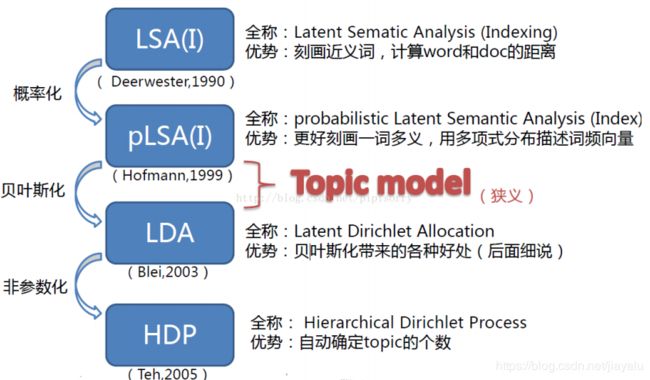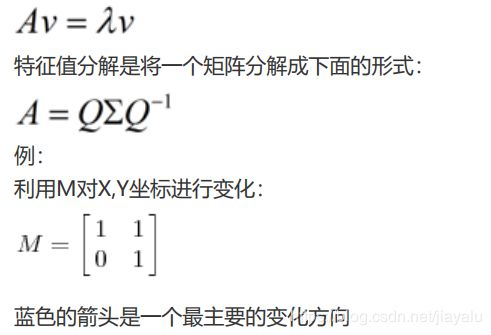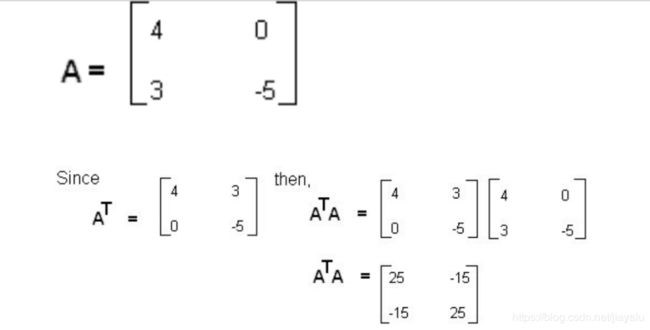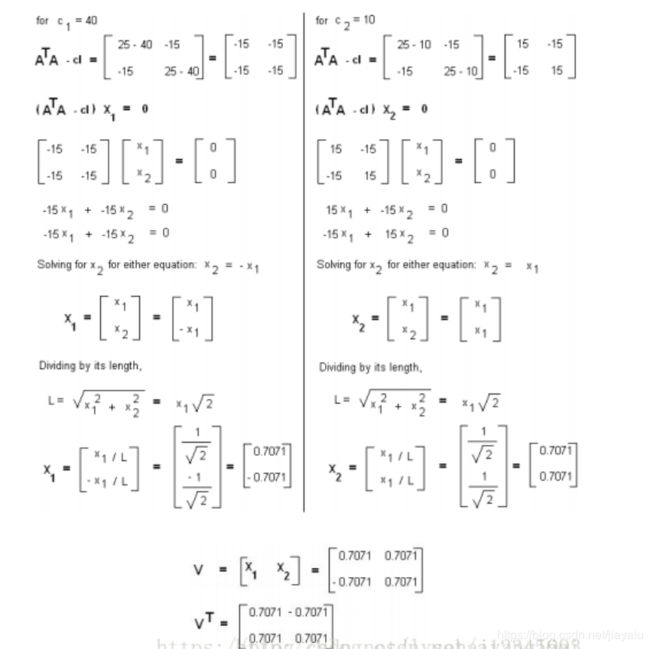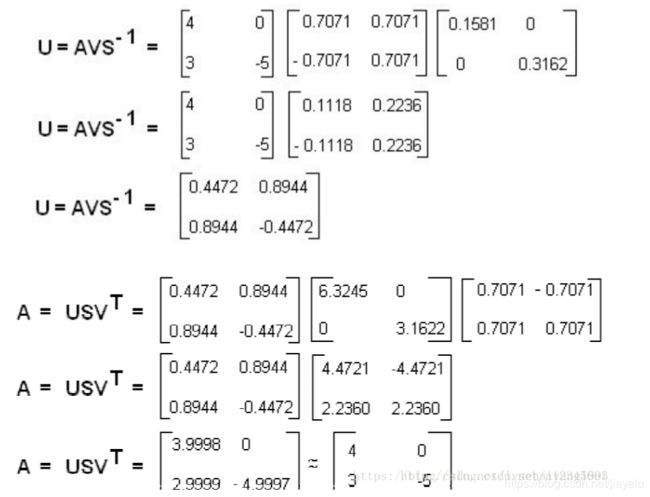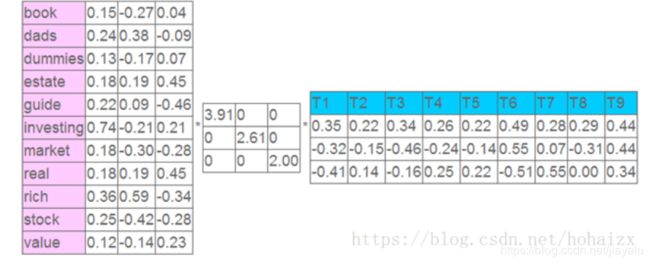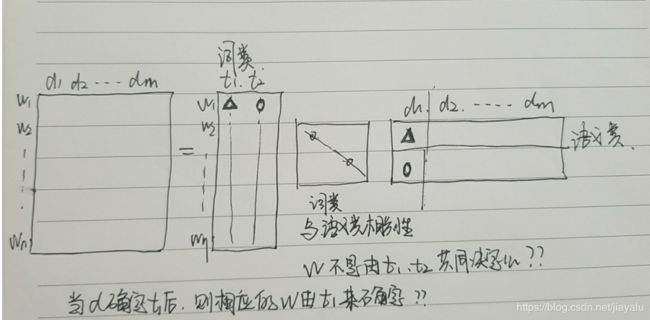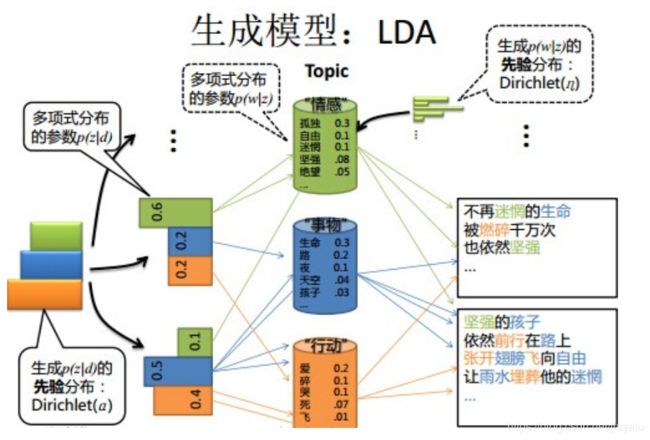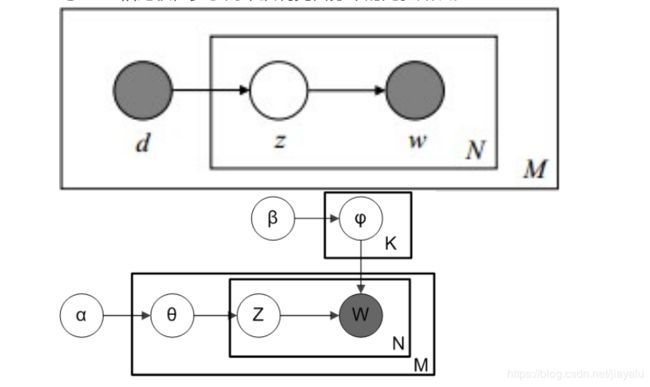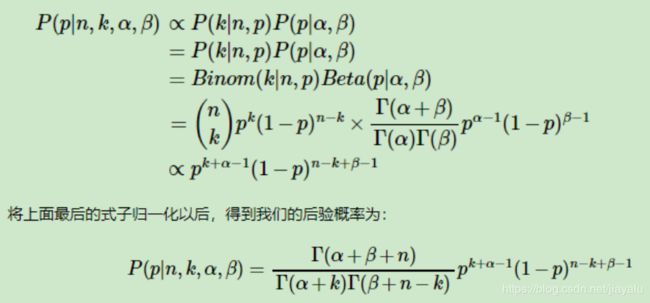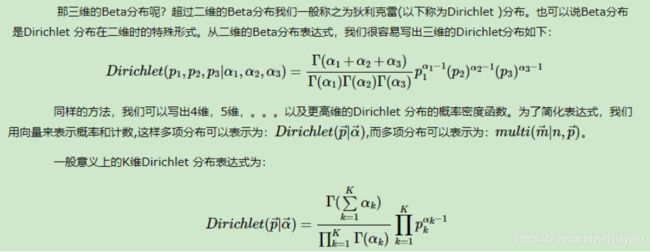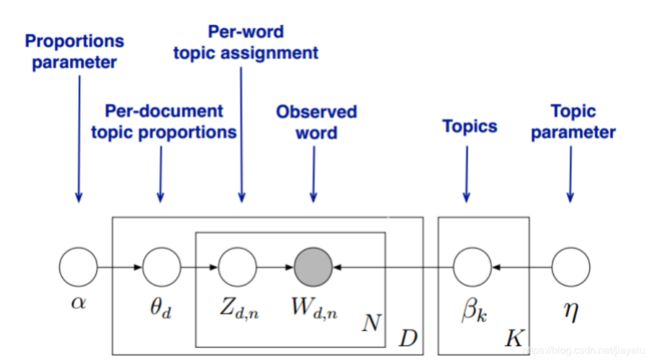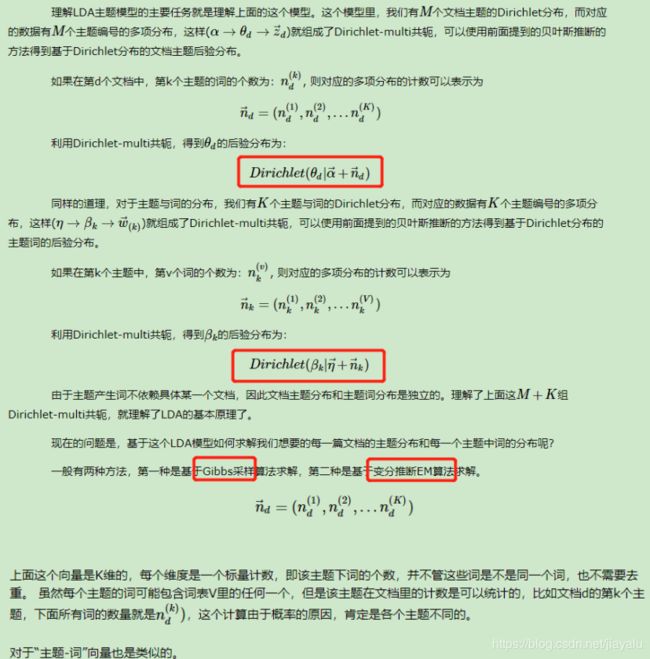主题模型
文章目录
- 主题模型
- 定义
- 主题模型历史
- 简单案例引入
- 知识储备:SVD——奇异值分解
- 1、特征值
- 2、SVD分解
- 3、SVD与PCA
- PLSA——概率隐性语义分析
- 1、SVD
- 2、LSA
- 3、PLSA
- PlSA原理
- 应用
- 1、 PLSA:文档生成模型
- 2、利用文档推断主题分布
- 3、PLSA算法的EM推导
- LDA
- 模型示意图:
- 案例:主题预测——基于gensim
- 1、步骤:
- 2、 代码
- 3、部分结果
- 案例:主题预测——基于sklearn
- 1、步骤
- 2、代码
- 3、结果分析
- LDA 原理
- 1、狄利克雷函数
- 2、狄利克雷分布
- 3、共轭分布
- LDA贝叶斯模型
- 二项分布和BETA分布
- 多项分布和Dirichlet分布
- 4、LDA主题模型
主题模型
定义
主题模型(topic model)是以非监督学习的方式对文集的隐含语义结构(latent semantic structure)进行聚类(clustering)的统计模型。
主题模型主要被用于自然语言处理(Natural language processing)中的语义分析(semantic analysis)和文本挖掘(text mining)问题,例如按主题对文本进行收集、分类和降维;也被用于生物信息学(bioinfomatics)研究 [2] 。隐含狄利克雷分布Latent Dirichlet Allocation, LDA)是常见的主题模型。
主题模型历史
简单案例引入
通过建立判断是否为算法大牛:
特征:
- 穿条纹衬衫
- 曾在BAT就职
- 做过大型项目
知识储备:SVD——奇异值分解
1、特征值
2、SVD分解
通过案例手推SVD
python实现
import numpy as np
A = np.array([[2, 4], [1, 3], [0, 0], [0, 0]])
print(np.linalg.svd(A))
3、SVD与PCA
PCA理解和含义
- PCA的问题其实是一个基的变换,使得变换后的数据有着最大的方差。
- 我们用于机器学习的数据(主要是训练数据),方差大才有意义,不然输入的数据都是同一个点,那方差就为0了,这样输入的多个数据就等同于一个数据了。
- 对原始的空间中顺序地找一组相互正交的坐标轴,第一个轴是使得方差最大的,第二个轴是在与第一个轴正交的平面中使得方差最大的,第三个轴是在与第1、2个轴正交的平面中方差最大的,这样假设在N维空间中,我们可以找到N个这样的坐标轴,我们取前r个去近似这个空间,这样就从一个N维的空间压缩到r维的空间了,但是我们选择的r个坐标轴能够使得空间的压缩使得数据的损失最小。
SVD推导PCA
SVD其实是两个方向上的PCA
PCA是对AA ^T的分解
而SVD是:U的列是AAT的特征向量,V的列是AT*A的特征向量
也可以通过SVD分解公式,利用求得得V求解 U(如上面手推求解答的案例)
PLSA——概率隐性语义分析
Probabilistic Latent Semantic Analysis
1、SVD
参考博客:https://blog.csdn.net/chlele0105/article/details/12983833
大矩阵A来描述这一百万篇文章和五十万词的关联性。这个矩阵中,每一行对应一篇文章,每一列对应一个词。
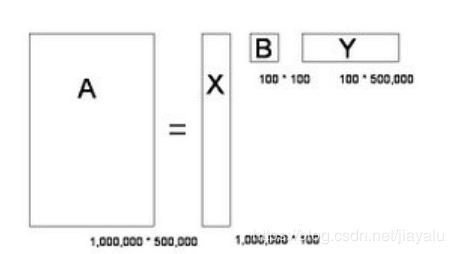

三个矩阵有非常清楚的物理含义。第一个矩阵X是对词进行分类的结果,每一列表示一类主题,其中的每个非零元素表示一个主题与一篇文章的相关性,数值越大越相关。最后一个矩阵Y中的每一列表示100个语义类/词类,每个语义类/词类与500,000个词的相关性。中间的矩阵则表示文章主题和语义类/词类之间的相关性。因此,我们只要对关联矩阵A进行一次奇异值分解,就可以同时完成了近义词分类和文章的分类。(同时得到每类文章和每类词的相关性)。
2、LSA
与上面1不同的是行列转置:行代表单词在每篇文档中出现的次数,列代表一篇文档中出现词语的分布。
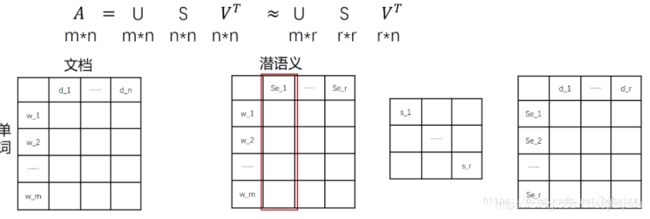
依据奇异值分解的性质1,矩阵A可以分解出n个特征值,然后依据性质2,我们选取其中较大的r个并排序,这样USVT就可以近似表示矩阵AA。对于矩阵U,每一列代表一个潜语义,这个潜语义的意义由m个单词按不同权重组合而成。因为U中每一列相互独立,所以r个潜语义构成了一个语义空间。S中每一个奇异值指示了该潜语义的重要度。VT中每一列仍然是一篇文档,但此时文档被映射了语义空间。V^T的大小远小于A。
有了VT,我们就相当于有了矩阵AA的另外一种表示,之后我们就可以使用VT代替A进行之后的工作。
流程
(1)分析文档集合,建立词汇-文本矩阵A。
(2)对词汇-文本矩阵进行奇异值分解。
(3)对SVD分解后的矩阵进行降维
(4)使用降维后的矩阵构建潜在语义空间
表示我们将文档映射到了一个3维语义空间中,其中第一维潜语义可以表示为

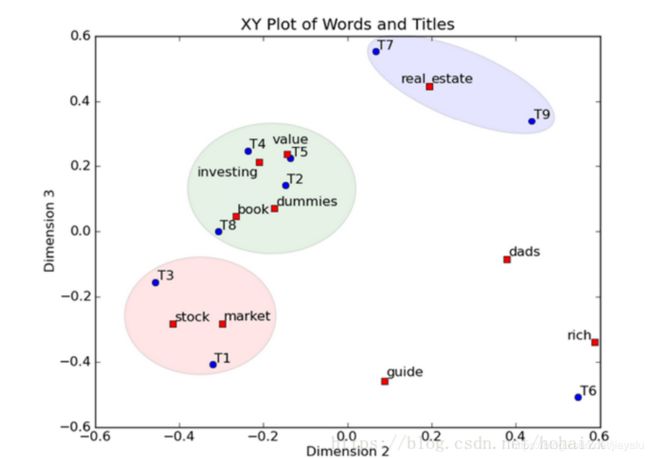
在图上,每一个红色的点,都表示一个词,每一个蓝色的点,都表示一个title,这样我们可以对这些词和title进行聚类,比如stock和market可以放在一类,这也符合他们经常出现在一起的直觉,real和estate可以放在一类,dads,guide这种词就看起来有点孤立了,我们就不对他们进行合并了。对于title,T1和T3可以聚成一类,T2、T4、T5和T8可以聚成一类,所以T1和T3比较相似,T2、T4、T5和T8比较相似。按这样聚类出现的效果,可以提取文档集合中的近义词,这样当用户检索文档的时候,是用语义级别(近义词集合)去检索了,而不是之前的词的级别。这样一减少我们的检索、存储量,因为这样压缩的文档集合和PCA是异曲同工的,二可以提高我们的用户体验,用户输入一个词,我们可以在这个词的近义词的集合中去找,这是传统的索引无法做到的。
LSA的优缺点
-
优点
1)低维空间表示可以刻画同义词,同义词会对应着相同或相似的主题。
2)降维可去除部分噪声,是特征更鲁棒。
3)充分利用冗余数据。
4)无监督/完全自动化。
5)与语言无关。 -
缺点
1)LSA可以处理向量空间模型无法解决的一义多词(synonymy)问题,但不能解决一词多义(polysemy)问题。因为LSA将每一个词映射为潜在语义空间中的一个点,也就是说一个词的多个意思在空间中对于的是同一个点,并没有被区分。
2)SVD的优化目标基于L-2 norm 或者 Frobenius Norm 的,这相当于隐含了对数据的高斯分布假设。而 term 出现的次数是非负的,这明显不符合Gaussian假设,而更接近Multi-nomial分布。(需要进一步研究为什么)
3)特征向量的方向没有对应的物理解释。
4)SVD的计算复杂度很高,而且当有新的文档来到时,若要更新模型需重新训练。
5)没有刻画term出现次数的概率模型。
6)对于count vectors 而言,欧式距离表达是不合适的(重建时会产生负数)。
7)维数的选择是ad-hoc的。
8)LSA具有词袋模型的缺点,即在一篇文章,或者一个句子中忽略词语的先后顺序。
9)LSA的概率模型假设文档和词的分布是服从联合正态分布的,但从观测数据来看是服从泊松分布的。因此LSA算法的一个改进PLSA使用了多项分布,其效果要好于LSA。
LSA——python实现
gensim
class gensim.models.lsimodel.LsiModel(corpus=None, num_topics=200, id2word=None, chunksize=20000, decay=1.0, distributed=False, onepass=True, power_iters=2, extra_samples=100, dtype=
-
关键参数:
corpus:文本语料
num_topic:保留的语义维数
id2word:ID到单词映射 -
该对象包括如下方法:
LsiModel.projection.u,获得左奇异向量;
LsiModel.projection.s,获得奇异值;
add_documents(),用新的语料更新模型;
get_topics(),获取所有潜语义的向量表示;
save(),保存模型到本地;
load(),从本地加载模型;
print_topic(topicno, topn=10),以string的形式输出第topicno个潜在语义的前topn个单词表示;
print_topics(num_topics=20, num_words=10),以string形式输出前num_topics个潜在语义,每个语义用num_words个单词表示;
show_topic(topicno, topn=10),获取定义第topicno个潜在语义的单词及其贡献;
from gensim.test.utils import common_corpus,common_dictionary,get_tmpfile
from gensim.models import LsiModel
#构建模型
print(common_corpus)
'''
#[[(0, 1), (1, 1), (2, 1)], [(0, 1), (3, 1), (4, 1), (5, 1), (6, 1), (7, 1)], [(2, 1), (5, 1),......
输出的为bag-of-word后的元组,(id,count)
#语料为:common_texts = [
['human', 'interface', 'computer'],
['survey', 'user', 'computer', 'system', 'response', 'time'],
['eps', 'user', 'interface', 'system'],
['system', 'human', 'system', 'eps'],
['user', 'response', 'time'],
['trees'],
['graph', 'trees'],
['graph', 'minors', 'trees'],
['graph', 'minors', 'survey']
]
'''
model = LsiModel(common_corpus[:3],id2word=common_dictionary,num_topics=3)
#将文档映射到语义空间
vector = model[common_corpus[4]]
#更新模型
model.add_documents(common_corpus[4:])
tmp_fname = get_tmpfile("lsi.model")
model.save(tmp_fname) # save model
loaded_model = LsiModel.load(tmp_fname) # load model
umatri = loaded_model.projection.u
print(umatri)
print(umatri.shape)
ss = umatri = loaded_model.projection.s
print(ss)
allt = loaded_model.get_topics()
print(allt)
t1 = loaded_model.print_topic(1,topn=12)
print(t1)
s1 = loaded_model.show_topic(1,topn=12)
print(s1)
[[(0, 1), (1, 1), (2, 1)], [(0, 1), (3, 1), (4, 1), (5, 1), (6, 1), (7, 1)], [(2, 1), (5, 1), (7, 1), (8, 1)], [(1, 1), (5, 2), (8, 1)], [(3, 1), (6, 1), (7, 1)], [(9, 1)], [(9, 1), (10, 1)], [(9, 1), (10, 1), (11, 1)], [(4, 1), (10, 1), (11, 1)]]
[[ 0.31308271 0.04475507 0.19130952]
[ 0.06218628 0.02061632 0.33478657]
[ 0.19775074 0.06519182 0.65889099]
[ 0.39382732 0.05923975 -0.3405499 ]
[ 0.29531217 -0.18289329 -0.18223293]
[ 0.38646088 0.06871426 0.18062738]
[ 0.39382732 0.05923975 -0.3405499 ]
[ 0.52939178 0.10381526 -0.01644547]
[ 0.13556445 0.04457551 0.32410443]
[ 0.0363079 -0.53458542 0.11367757]
[ 0.08395235 -0.65620128 0.0321324 ]
[ 0.07242846 -0.46795875 -0.01133593]]
(12, 3)
[3.03555067 2.51654597 1.88136386]
[[ 0.31308271 0.06218628 0.19775074 0.39382732 0.29531217 0.38646088
0.39382732 0.52939178 0.13556445 0.0363079 0.08395235 0.07242846]
[ 0.04475507 0.02061632 0.06519182 0.05923975 -0.18289329 0.06871426
0.05923975 0.10381526 0.04457551 -0.53458542 -0.65620128 -0.46795875]
[ 0.19130952 0.33478657 0.65889099 -0.3405499 -0.18223293 0.18062738
-0.3405499 -0.01644547 0.32410443 0.11367757 0.0321324 -0.01133593]]
-0.656*“graph” + -0.535*“trees” + -0.468*“minors” + -0.183*“survey” + 0.104*“user” + 0.069*“system” + 0.065*“interface” + 0.059*“time” + 0.059*“response” + 0.045*“computer” + 0.045*“eps” + 0.021*“human”
[(‘graph’, -0.6562012837041503), (‘trees’, -0.5345854212634996), (‘minors’, -0.46795875376068946), (‘survey’, -0.18289328901588417), (‘user’, 0.10381525918751365), (‘system’, 0.06871425877803433), (‘interface’, 0.06519182403581872), (‘time’, 0.05923975195143014), (‘response’, 0.059239751951430136), (‘computer’, 0.044755068341685994), (‘eps’, 0.044575507236083514), (‘human’, 0.02061631679973524)]
3、PLSA
参考链接:https://www.cnblogs.com/Determined22/p/7237111.html
https://blog.csdn.net/pipisorry/article/details/42560693
pLSA 模型是有向图模型,将主题作为隐变量,构建了一个简单的贝叶斯网,采用EM算法估计模型参数。
由于PLSA属于LSA到LDA的过滤,很少被使用~~ 可以减少研究!
[外链图片转存失败(img-uA7SMdbB-1567562386972)(en-resource://database/1825:1)]
PlSA原理
公式推导
[外链图片转存失败(img-zgYhWFjo-1567562386973)(en-resource://database/1827:1)]
PLSA性质
应用
1、 PLSA:文档生成模型
类似于掷色子的游戏,假定好主题个数后,建立“文档-主题”筛子,这个就是主题分布;之后建立“主题-词项”筛子,这个是词分布,两个分布都是多项式分布。
选主题和选词都是两个随机的过程,先从主题分布{教育:0.5,经济:0.3,交通:0.2}中抽取出主题:教育,然后从该主题对应的词分布{大学:0.5,老师:0.3,课程:0.2}中抽取出词:大学。
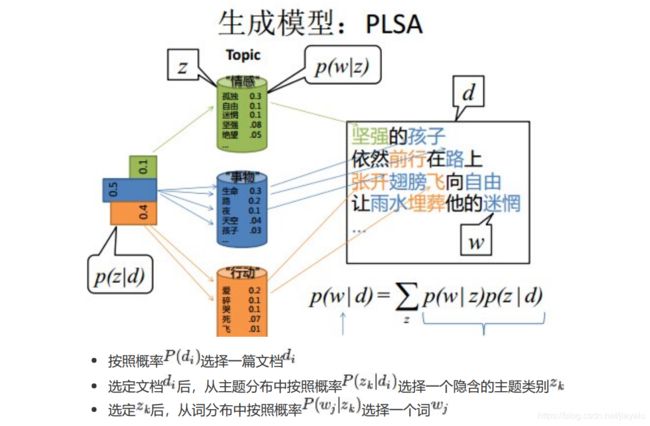
2、利用文档推断主题分布
主题建模的目的:自动地发现文档集中的主题(分布)。
这个图的意思是,文档中的每一个词都是先选定一个主题,再从中选择词得到;文档中的每个词并不一定对应同一个主题z(z放在了小方框的里面了)。
d和w是可以通过样本得到的,所以对于任意一篇文档,其p(w|d)是已知的。


【PLSA,样本随机,参数未知但是固定,所以PLSA属于频率派思想。区别于LDA:样本固定,参数未知且不固定,是个随机变量,服从一定的分布,所以LDA属于贝叶斯派思想。?】
3、PLSA算法的EM推导
LDA
Latent Dirichlet allocation——隐含狄利克雷分布
主要应用领域:文本主题识别、文本分类以及文本相似度计算。
无监督学习,需要文档集和主题数
可以用一些词语来表示主题
模型示意图:
案例:主题预测——基于gensim
1、步骤:
-
1、查看数据
-
2、分词 :jieba 、df.apply(fun)
-
3、预处理:去除标点、英文、停用词(需要停用词表)
-
4、生成词典:
from gensim import corpora dictionary = corpora.Dictionary(tokenized_corpus)#Dictionary(615 unique tokens: [‘高血压’, ‘减轻’, ‘周身’, ‘咳嗽’, ‘流涕’]…)
其中:tokenized_corpus为分词预处理后的语料列表 -
5、生成稀疏矩阵
doc_term_matrix = [dictionnary.doc2bow(doc) for doc in tolenised_corpus]#[[(0, 1)], [(1, 1), (2, 1), (3, 1), (4, 1)], [(5, 1), (6, 1), (7, 1), (8, 1), (9, 1), (10, 1), (11, 1), (12, 1), (13, 2), (14, 2), (15, 1), (16, 1)],…
-
6、训练模型
lda = LdaModel(doc_term_matrix,num_topics=20,id2word=dictionary,) -
7、保存模型
lda.save(fname= "yiyaoLdaModel") -
8、预测给定文档的主题分布
文本预处理,转化为“词+词频”的词矩阵
分词
去除停用词
dictionary.doc2bow(list(text_list))#转化为词矩阵
lda模型预测:lda[dictionary.doc2bow(list(text_list))]#主题+权重
print(max(lda_vector, key=lambda item: item[1]))##权重最大的主题标号+权重
2、 代码
"""
@version: 3.7
@author: jiayalu
@file: ldaModel.py
@time: 09/08/2019 09:36
@description: 利用LDA模型获取主题,利用gensim训练
步骤:
1、查看数据
2、分词 :jieba 、df.apply(fun)
3、预处理:去除标点、英文、停用词、
4、生成词典:from gensim import corpora dictionary = corpora.Dictionary(tokenized_corpus)
5、生成稀疏矩阵
6、训练模型
7、预测给定文档的主题分布
"""
#查看数据,并选取有用数据、修改表头
import pandas as pd
df = pd.read_csv("E:\pythoncode\drugdescrib1.csv",encoding="utf-8")
print(df.head())
df.rename(columns = {"【药品名称】":"name","【适应症】":"illness"},inplace=True)
df1 = df[["name","illness"]]
print(df1.head())
#分词
import jieba
def chinese_word_cut(mytext):
return " ".join(jieba.cut(str(mytext)))
print(df1.illness.head())
df["content_citted"] = df1.illness.apply(chinese_word_cut)
print(df.content_citted.head())
#预处理:去除停用词、标点
import re
from nltk.corpus import stopwords
def load_punctuations():
pun_list = []
with open("./pun_list.txt",encoding="utf-8")as fr:#表达符号数据
for line in fr:
line = line.strip()
pun_list.append(line)
return pun_list
#英文停用词
# english_stopwords = stopwords.words("english")
chinese_stopwords = {}.fromkeys([line.strip() for line in open("chinese_stopwords.txt",encoding="utf-8")])#中文停用词文件
pun_list = load_punctuations()
def clean_text(text):
text = text.strip()
for pun in pun_list:
text = text.replace(pun , " ")
# new_text = ' '.join([w for w in text.split() if w not in english_stopwords and w not in chinese_stopwords and len(w)>1])
new_text = ' '.join([w for w in text.split() if w not in chinese_stopwords and len(w) > 1])
return new_text
import gensim
from gensim.models.ldamodel import LdaModel
from gensim import corpora
from nltk import wordpunct_tokenize
class Token_Corpus(object):
def __init__(self, corpus):
self.corpus = corpus
def __iter__(self):
for text in self.corpus:
text = text.strip()
text = clean_text(text)
yield self.tokenize(text)
def tokenize(self, text):
token = wordpunct_tokenize(text)
return token
document = list(df["content_citted"])
print(document)
tokenized_corpus = Token_Corpus(document)
print(tokenized_corpus)
# for i in tokenized_corpus:
# print(i)
#生成字典
dictionary = corpora.Dictionary(tokenized_corpus)
dictionary.filter_extremes(no_below=10,no_above=0.10)
print(dictionary)#Dictionary(615 unique tokens: ['高血压', '减轻', '周身', '咳嗽', '流涕']...)
# for i in dictionary:
# print(i)#数字0,1,2,3.....
#生成稀疏矩阵
class MyCorpus(object):
def __init__(self, token_list, dictionary):
self.token_list = token_list
self.dictionary = dictionary
def __iter__(self):
for tokens in self.token_list:
yield self.dictionary.doc2bow(tokens)
doc_term_matrix = [dictionary.doc2bow(doc) for doc in tokenized_corpus]
print(doc_term_matrix)
# corpus = MyCorpus(tokenized_corpus,dictionary)
# mm_corpus = gensim.corpora.MmCorpus('data_science.mm')
# print(mm_corpus)
#训练模型
# lda = LdaModel(doc_term_matrix,num_topics=20,id2word=dictionary,)
# print(lda.print_topics(num_topics=5,num_words=5))
# lda.save(fname= "yiyaoLdaModel")
text = """
1 肾动脉狭窄有报道称:ACE抑制剂可能使单侧或者双侧肾动脉狭窄患者的血肌酐或者血尿素氮(BUN)升高,但还没有在此类患者中长期使用本品的经验,但是可能会出现类似的结果。
2 肾功能损害在那些肾功能依赖于肾素-血管紧张素-醛固酮系统活性的患者中(如严重的充分性心力衰竭患者)使用ACE抑制剂和AT1 受体拮抗剂,可能出现少尿和/或进行性氮质免疫,
性肾功能衰竭和/或死亡(罕见),在此类患者中使用奥美沙坦酯治疗。3 胎儿/新生儿发病和死亡3.胎儿/新生儿发病和死亡对D类妊娠(第Ⅱ期和第Ⅲ期),直接作用于RAS的药物与胎儿
和新生儿的损伤有关。一旦发现妊娠,应当尽快停止使用本品。如果必须用药,应当告知这些孕妇关于药物对他们胎儿的潜在危害,并进行系列超声波检查来评估羊膜内的情况。曾经在
子宫内与血管紧张素Ⅱ受体拮抗剂接触过的婴儿应密切监测其血压过低,少尿和高血钾的情况,必要时做适当的治疗。 4 血容量不足或者低钠患者的低血压血容量不足或者低钠患者
(例如那些使用大剂量利尿剂治疗的患者),在首次服用本品后可能会发生症状性低血压,必须在周密的医疗监护下使用该药治疗。如果发生低血压,患者应仰卧,必要时静脉注射生理盐水。
一旦血压稳定,可继续用本品治疗。"""
text1 ="""
适用于敏感菌(不产β内酰胺酶菌株)所致的下列感染:1溶血链球菌、肺炎链球菌、葡萄球菌或流感嗜血杆菌所致中耳炎、鼻窦炎、咽炎、扁桃体炎等上呼吸道感染。
2大肠埃希菌、奇异变形杆菌或粪肠球菌所致的泌尿生殖道感染。
3溶血链球菌、葡萄球菌或大肠埃希菌所致的皮肤软组织感染。
4溶血链球菌、肺炎链球菌、葡萄球菌或流感嗜血杆菌所致急性支气管炎、肺炎等下呼吸道感染。5急性单纯性淋病。7本品尚可用于治疗伤寒"""
lda = LdaModel.load("yiyaoLdaModel")
text_list = clean_text(chinese_word_cut(text)).split(" ")#分词后的列表,['适用', '敏感', '不产', '内酰胺酶' ..
print(text_list)
print("bow___________________________")
print(dictionary.doc2bow(list(text_list)))#词矩阵:词+词频#[(29, 1), (30, 1), (31, 1), (32, 2), (33, 2), (34, 1), (35, 1), (36, 1), (37, 3), (38, 1), (39, 1), (40, 1), (41, 3), (114, 1), (137, 1), (145, 1)]
# lda_vector = lda[dictionary.doc2bow(list(text_list))]
lda_vector = lda[dictionary.doc2bow(list(text_list))]
print(lda_vector)#主题标号+权重
# Prints the most likely Topic. Performs Max based on the 2nd element in the tuple
print(max(lda_vector, key=lambda item: item[1]))##权重最大的主题标号+权重
print(lda.print_topic(max(lda_vector, key=lambda item: item[1])[0]))
# print()
3、部分结果
案例:主题预测——基于sklearn
1、步骤
1、加载数据
读取——分词——写入
数据格式为 “沙 瑞金 向 毛娅 打听 他们 家 在 京州 的 别墅 , 毛娅 笑 着 说 , 王 大路 事业有成 之后 , 要 给 欧阳 菁 和 她 公司 的 股权 , 她们 没有 要 , 王 大路 就 在 京州帝 豪园 买 了 三套 别墅 , 可是 李达 康和易 学习 都 不要 , 这些 房子 都 在 王 大路 的 名下 , 欧阳 菁 好像 去 住 过 , 毛娅 不想 去 , 她 觉得 房子 太大 很 浪费 , 自己 家住 得 就 很 踏实 。”
2、加载停用词
读取——写入list
3、统计训练语料的词频
from sklearn.fearure_extraction.text import CountVectorizer
from sklearn.externals import joblib
#训练语料,res1,res2,res3,...为读取的文本
corpus = [res1,res2,res3...]
#加载模型
cntVector = CountVectorizer(stop_words=stopwrd_list)
cntTf = cntVector.fit_transform(corpus)
#保存便于测试时加载使用
joblib.dump(cntVector, "cntVector")
cntTf:(文档索引,词索引) 词频
4、训练模型
lda = LatentDirichletAllocation(n_components=2, max_iter=5,learning_method='online',learning_offset=50.,random_state=0)
docres = lda.fit(cntTf)
with open("lda.pickle", "wb") as fw:
pickle.dump(docres,fw)print(docres)
5、查看主题词
def print_top_words(lda, features_names, n_top_words):
for topic_idx, topic in enumerate(lda.components_):
print("Topic#%d"%topic_idx)
print(" ".join([features_names[i] for i in topic.argsort()[:-n_top_words-1:-1]]))
n_top_words = 50
tf_fearures_names = cntVector.get_feature_names()
print_top_words(lda,tf_fearures_names,n_top_words)
6、预测
加载数据——加载词频统计——格式转换———加载模型——预测
cut_content("nlp_test2.txt")
res2 = get_corpus("cut_nlp_test2.txt")
corpus2 = [res2]
cntVectorload = joblib.load("cntVector")
print(cntVectorload)
cntTf2 = cntVectorload.transform(corpus2)
print(cntTf2)
cntTf2.toarray()
with open("lda.pickle", "rb") as fr:
lda = pickle.load(fr)
topic_dist = lda.transform(cntTf2)
print(topic_dist)
注意训练模型用fit,预测模型用transform
2、代码
"""
@version: 3.7
@author: jiayalu
@file: ldaOfsklearn.py
@time: 13/08/2019 09:45
@description: 利用sklearn 库中的lda训练模型
步骤:
1、加载数据,加载停用词典,都转化为列表形式
2、利用CountVectorizer统计词频并保存,便于对新的预测文本进行转化
3、lda模型训练
4、预测
"""
import jieba
#加载数据,分词
def cut_content(filename):
with open(filename, "r", encoding="utf-8") as f:
document = f.read()
document_cut = jieba.cut(document)
result = " ".join(document_cut)
with open("cut_" + filename, "w", encoding="utf-8")as f2:
f2.writelines(result)
f.close()
f2.close()
# print(n)
#加载停用词典
stopwrd_dic = open("stopword.txt", "r", encoding="utf-8")
stopwrd_content = stopwrd_dic.read()
stopwrd_list = stopwrd_content.splitlines()
stopwrd_dic.close()
#读取预处理后的数据
def get_corpus(filename):
with open(filename, "r", encoding="utf-8")as f:
resf = f.read()
return resf
cut_content("nlp_test1.txt")
res1 = get_corpus("cut_nlp_test1.txt")
#一般是基于词频的统计,很少用tfidf
# from sklearn.feature_extraction.text import TfidfVectorizer
# corpus = [res1]
# vector = TfidfVectorizer(stop_words=stopwrd_list)
# tfidf = vector.fit_transform(corpus)
# print(vector.get_feature_names())
# print(tfidf)
# print(tfidf.shape)
#
# wordlist = vector.get_feature_names()#获取词袋模型中的所有词
# #tf-idf矩阵 元素a[i][j]表示j词在i类文本中的tf-idf权重
# weightlist = tfidf.toarray()
# print(weightlist)
# for i in range(len(weightlist)):
# print("-------第",i,"段文本的词语tf-idf权重------" )
# for j in range(len(wordlist)):
# print(wordlist[j],weightlist[i][j])
#统计词频
from sklearn.feature_extraction.text import CountVectorizer
from sklearn.decomposition import LatentDirichletAllocation
from sklearn.externals import joblib
import pickle
corpus1 = [res1]
cntVector = CountVectorizer(stop_words=stopwrd_list)
cntTf = cntVector.fit_transform(corpus1)
joblib.dump(cntVector, "cntVector")#保存cntVector,避免二次运算
print(cntTf)
print(cntTf.toarray())#矩阵,文档-词频
#模型训练
lda = LatentDirichletAllocation(n_components=2, max_iter=5,learning_method='online',learning_offset=50.,random_state=0)
docres = lda.fit(cntTf)
with open("lda.pickle", "wb") as fw:
pickle.dump(docres,fw)
print(docres)
#topic top words
def print_top_words(lda, features_names, n_top_words):
for topic_idx, topic in enumerate(lda.components_):
print("Topic#%d"%topic_idx)
print(" ".join([features_names[i] for i in topic.argsort()[:-n_top_words-1:-1]]))
n_top_words = 50
tf_fearures_names = cntVector.get_feature_names()
print_top_words(lda,tf_fearures_names,n_top_words)
#预测
cut_content("nlp_test2.txt")
res2 = get_corpus("cut_nlp_test2.txt")
corpus2 = [res2]
cntVectorload = joblib.load("cntVector")
print(cntVectorload)
cntTf2 = cntVectorload.transform(corpus2)
print(cntTf2)
cntTf2.toarray()
with open("lda.pickle", "rb") as fr:
lda = pickle.load(fr)
topic_dist = lda.transform(cntTf2)
print(topic_dist)
3、结果分析
返回的是主题矩阵,预测文本属于那个主题的概率。
可以通过查看主题词分布,获取预测文本的主题词分布

LDA 原理
1、狄利克雷函数
Dirichlet function
定义:定义在实数范围内、值域不连续的函数。以Y轴为对称轴,偶函数,处处不连续。
值域的取值为{0,1},当x为有理数时,D(x)=1,无理数时,D(x)=0。
2、狄利克雷分布
3、共轭分布
LDA贝叶斯模型
LDA是贝叶斯模型的,有3块构成:
先验分布 + 似然(数据) = 后验分布
例如:好人坏人,
先验分布:100好人,100坏人
数据:2个好人,1个坏人
后验分布:102好人,101坏人
这个后验分布变更成了下一次的先验分布,依次更新下去。
二项分布和BETA分布
希望先验分布 + 似然(二项分布)得到的后验分布能够作为下一次的先验分布。为此我们希望找到一个与二项式分布共轭的分布,即Beta分布。

多项分布和Dirichlet分布
根据上面的二项分布和Beta分布进行延申,对应于多项分布和Dirichlet分布。
4、LDA主题模型
主题-词分布是基于语料的,而文档主题分布是基于一篇文档的。
则对于一篇文本,首先通过Dirichlet-Multi分布确定主题分布,针对某个一主题根据训练好的DIrichlet-Multi分布确定词分布。示例如下:

